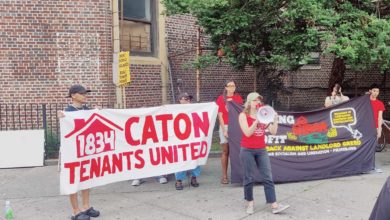The writer is a student organizer at Florida Atlantic University.
Miami is facing a housing crisis that has seen thousands of families displaced amidst a real estate boom that has reshaped the city’s skyline with luxury condominiums.
When the pleas of the voiceless fall on the deaf ears of elected officials in Miami-Dade County, students at Florida
|
Students from a sizeable alliance of organizations, including ANSWER/FIU (Act Now to Stop War and End Racism), the Bolivarian Youth and the Center for Pan-African Development, have come together to build a replica of a shantytown in nearby Liberty City that was built in October 2006. The mock shantytown sits among the pristine buildings of the FIU South Campus.
Miami’s local government was rocked when it learned that its housing authority squandered millions of dollars that was earmarked for low income housing. Instead, money went to private insider deals, pet projects and advances on loans to corporate developers.
Meanwhile, empty lots and displaced low income families bore the brunt of the housing authority’s collective greed.
Umoja Village—Umoja is “unity” in Swahili—arose in response to the housing scandal. It was built without permission by housing activists on government land to meet the immediate needs of Miami’s homeless population.
Since its construction, the activist community of South Florida has united in a joint effort to defend the shantytown and its 40 residents against attacks by city commissioners, police and other political opponents.
Students take leadership role
On Feb. 19, students from FIU and UM began erecting the mock shantytown. Since then, they have slept in the cardboard and wooden tenements to bring the realities of Miami’s housing situation to the student population and campus workers.
Muhammed Malik, a student and president of ANSWER/FIU, has helped erect the mock shantytown. He told PSLweb.org about the need for raising awareness and about the dire need for social change. “The United States needs to re-think its perspective. Instead of fighting a war in Iraq, the U.S. should fight a war against poverty and racism.”
Miami, which has become a U.S. center for international business and trade, lacks the political leadership to work against unnecessary poverty and homelessness. It has become the least affordable city to live in the United States.
Malik continued, “You would think that since Miami is one of the poorest cities in the U.S. that its government officials would keep their hands out of the cookie jar. Unfortunately, they haven’t done so. Millions of dollars were either stolen or inappropriately doled out.”
Among the student organizers, Chris Daley, who has been forced to live out of his car while attending FIU, had a strong message for students. “I’m just trying to bring awareness. We tend to put the plight squarely on the individual’s shoulders, but we also have social responsibility. Miami is failing a lot of its citizens, and it’s a shame.”
Over the past days, student organizers have created more than just a political statement. The mock shantytown that they have built will be transferred to the Umoja Village and reconstructed as a library filled with the books that were donated as part of collection done on camps this past week. Also, a food and clothing drive was started by students to help the residents of the shantytown.
Campus response
Sonja Swanson, president of the FIU chapter of the Bolivarian Youth, reflected on the success of the action taken by students. “Over 700 students have signed a petition, and the topic of homelessness and gentrification has permeated in all the students’ conversations,” said Swanson. “Awareness has been raised about this issue, and it has successfully been connected to other issues in our society like the war in Iraq and the state of the education system in the United States.”
Far from just a statement removed from the reality of life in the shantytown, Swanson stressed the cooperation between the students and the residents of Umoja Village: “They actually taught the college students how to build the FIU shanty. They showed us step by step. The process of building the shanty was incredible. A crowd of 40 students gathered to build it together from all different backgrounds and organizations.”
In Miami, the city’s corruption and greed reflects how other city governments around the country represent profit interests over the basic human needs of its denizens. However, the student organizers and activists have shown that youth leaders can expose this greed and work against it effectively.
ANSWER/FIU’s Muhammed Malik said, “This demonstration exemplifies FIU’s commitment to stand up against this injustice and to demand low-income housing as a basic human rights for all.”






